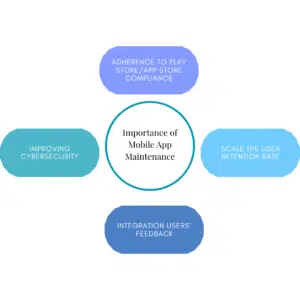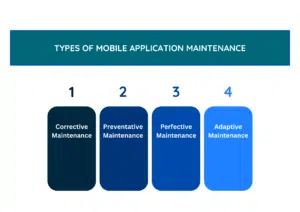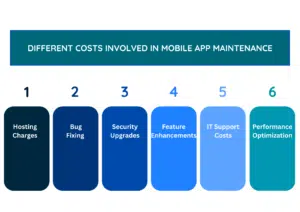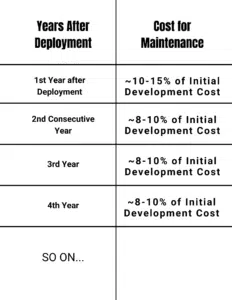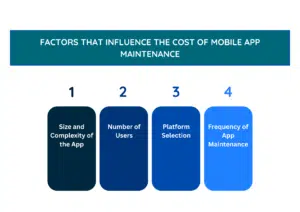Building a mobile application to conduct your business operations is not a one-time thing! You ought to prioritize its maintenance over time, ensuring it stays updated and guarantees unhindered performance in the long run of your business. Therefore, you must allocate a specific budget separately for mobile app maintenance.
The coding, designing, and deployment stages of building a mobile application are crucial to ensure your brand platform meets your business expectations. On the other hand, timely maintenance ensures it doesn’t experience traffic breakdowns, performance glitches, or functionality interruptions.
Without an adequate investment in mobile application maintenance, you might be risking app failure or performance drops. In either case, your users will be uninstalling the application, lowering your overall business productivity. So, if you are in a dilemma of how to budget your investment towards app maintenance, this guide is all you need!
Read along till the end to understand how much it costs to maintain an app, and what factors influence the total periodic expense.
Why is it Important to Seek Timely Maintenance of Mobile Apps?
There are numerous reasons why you must prioritize app maintenance over time, some of which are as follows:
1. Adhering to App Store/Play Store Compliance:
Apple’s App Store and Google’s Play Store impose some strict policies in order to maintain the quality of applications that are made available for download on them. For you to know, in the second quarter of 2024, around 1.1 million apps were delisted or taken off these stores for failing to meet the compliance requirements. One of the reasons includes, incompatibility of apps with newer OS versions.
Therefore, seeking mobile app maintenance ensures it stays compliant with App Store/Play Store policies. Upon neglecting it, your app might lose its reach, rankings, and visibility.
2. Improving Cybersecurity:
With every passing year, the cybersecurity threats are becoming more advanced and undetectable by traditional or existing measures. Therefore, a year-on-year app maintenance becomes necessary to improve the security attributes with better features. At the same time, professionals will also detect potential vulnerabilities and fix them before any attacker tries to exploit them.
Mobile apps house sensitive data, and the need for security patches or updates over time is a mandatory expectation of users. Investing in app maintenance will help you maintain the trust of users and repel the ever-evolving security threats.
3. Scale the User Retention Rate:
Poor performance is the primary reason why users are forced to uninstall an app, despite how rich your product or services are. You ought to be consistent with providing a better user experience with every passing year, ensuring your app design, performance, navigation, and other elements are adhering to the expectations of users at the time. Now, that’s possible with regular auditing and updates!
You must know that the overall cost of retaining an existing user is much lower than acquiring new ones. Therefore, spending a reasonable app maintenance cost per year can help you maintain prolonged user satisfaction and boost the overall retention rate.
4. Integrating Users’ Feedback
A good app-driven business always adheres to the feedback of users and takes necessary steps to meet their expectations. Therefore, regular maintenance of your mobile application will give you the chance to follow through with your users’ feedback and integrate the changes as suggested.
This way, you can enable smooth functionality of your mobile application and guarantee a robust experience for users. Beyond that, when you implement the users’ requests with year-on-year upgrades, it showcases your dedication to building a customer-centric business.
Types of Mobile Application Maintenance
Mobile app maintenance is a comprehensive approach towards holding onto the peak performance of the business platform. Therefore, this process is divided into four different types, all collectively contributing towards streamlining, upgrading, and updating the app functionalities:
1. Corrective Maintenance:
It is the initial stage of app maintenance where developers fix bugs, errors, or glitches in the code. If your mobile app has been reported for frequent crashes or broken features, corrective maintenance is the first stage of resolving the issues.
2. Preventative Maintenance:
The second most important maintenance approach is to prevent security threats from seeping into your mobile app, compromising users’ data. Tasks like security upgrades or code optimizations are done under this step, which helps lower the long-term expenses.
3. Perfective Maintenance:
It is the stage that demands feature upgrades, improved UI/UX, enhanced performance, and more. Basically, perfective maintenance is about keeping your mobile app competitive in the market, and it is the most expensive step of all.
4. Adaptive Maintenance:
What good is your mobile app if it isn’t compatible with the OS versions? Therefore, adaptive maintenance becomes critical to ensure your app aligns with the App Store or Play Store policies alongside hardware or functional compatibility.
What Add Up to the Total Cost of Mobile App Maintenance?
Now that you know the importance of updating and upgrading your mobile app over time, here’s a detailed insight into all the expenses that add up to the total cost of maintaining an app:
1. Hosting Charges:
You often pay an annual fee to the hosting company for deploying and keeping your app live on their server. When calculating the overall cost of app maintenance, hosting charges become one of the most significant expenses to take into consideration.
Depending on the data usage of your app, such as managing audio, texts, or videos, you can plan the server resources accordingly. You can either increase or decrease the capacity of your server resources. The average cost might range between $70 and $320/year.
There are diverse hosting options for you to explore if you want to save a few bucks on this aspect of maintenance costs. For instance, you can move to cloud hosting options to lower the yearly costs for the same server resources.
2. Bug Fixing
In order to scale the performance of your mobile app over time, you must prioritize detecting and fixing bugs on a periodic basis. Also, sometimes you will have to update the app to support the app store compliance or a major update made by the iOS or Android platforms. Updates for bug fixing and compliance should be a consistent effort, which will strongly impact the success quotient of your app.
3. Platform compliance
Both iOS and Android platforms are fond of releasing new updates multiple times a year. Therefore, it becomes paramount for you to maintain your app and ensure it stays compatible with the new OS updates.
Without such active IT support, your app will continue to experience downtimes, leading to poor user experience and lowered retention rates. You can partner with a reliable mobile app development company that offers post-launch maintenance and support solutions to help you with it.
4. Security Upgrades:
Security is non-negotiable when you are running a digital application to conduct your business operations. Every year, attackers find a way to leverage new vulnerabilities within your business system.
Therefore, to ensure your app stays safeguarded against all threats or vulnerabilities, app maintenance becomes critical. Experts adhere to the latest cybersecurity trends and optimize your app to deal with potential threats.
5. Feature Enhancements
Users are the best critics to let you know if your app is perfect or needs something more than it already has. This is the maintenance step where user feedbacks are collected, alongside a thorough analysis of market trends and booming technologies.
Expert mobile app developers will then relate the new findings to your business requirements and suggest the inclusion of new features.
Not just that, but irrelevant features flagged by users will also be removed in the process. This way, your app will get a complete makeover, and users can then enjoy a revamped performance.
6. Performance Optimization:
Among all other ongoing maintenance practices, it becomes important for you to monitor the speed, responsiveness, resource utilization, and other such aspects of your app. A team of experts must always conduct several tests to point out any technical flaws and fix them effectively.
How Much Does App Maintenance Cost?
Considering all the variables involved in maintaining a mobile application, here is a brief overview of how much cost you might have to bear over time for upgrading or updating it.
In the first year after deploying your mobile app, the maintenance cost will be the highest. It is because there might be a high volume of bug fixes, post-launch updates, or feedback-based improvements. Therefore, the app maintenance cost for the first year might be ~10-15% of the initial cost of development.
In the following years, the cost of app maintenance will stand at ~8-10% every year, including the recurring expenses like hosting, third-party API fees, App Store/Play Store developer fees, ongoing updates, security enhancements, etc. You might also feel the necessity of integrating new features every couple of years, which will add up to the overall maintenance costs.
What are the Factors that Influence the Cost of Mobile App Maintenance?
You are now aware of the different expenses meant for you to bear upon seeking periodic mobile app maintenance. However, the cost differs immensely depending on several influencing factors, which include:
1. Size & Complexity of the App:
If you are running a complex mobile app, loaded with a plethora of features & functionalities, it will be expensive for you to maintain it. On the other hand, a basic or simple application with standard design and features won’t demand much high of maintenance. It is because basic apps lack dependencies, integrations, and complex functionalities!
2. Number of Users:
If your app relies on heavy server resources for accommodating a large volume of users, you must expect to pay a hefty amount for maintenance. Unlike the apps with limited or small user volume, you will require more resources and user support processes, which will add to the overall maintenance costs.
3. Platform Selection:
If your app is built for just a single or native platform (iOS or Android), your cost of maintenance will be less. It is because the app updates for new OS versions will be done specifically for one ecosystem. On the other hand, a cross-platform mobile app maintenance cost increases by around 20% to 40%, considering both ecosystems are to be covered for app updates.
4. Frequency of App Maintenance:
If you aren’t investing in routine maintenance for your mobile app, your overall frequency of seeking upgrades or updates will increase. Thus, it will increase the cumulative cost of maintaining an app. Partner with one of the top mobile app development companies and avail of their ongoing support services to minimize the need for unforeseen maintenance expenses.
How to Reduce the Overall Cost of App Maintenance?
It is true that you ought to set aside a budget for seeking mandatory maintenance of your mobile app. However, you can always adopt practical tips to reduce the overall cost. Some of those tips are:
- Have a well-prepared maintenance plan with scheduled tasks, pre-defined business goals, and goal-driven feature upgrades. This will not just help you save on maintenance costs, but will also guide you with optimized resource utilization.
- Make sure you regularly test your mobile app and detect potential risk factors or vulnerabilities before they are exploited. This way, you will save yourself from spending big in the long run.
- Leverage the potential of Artificial Intelligence (AI) tools to enable automated testing for your mobile application. AI tools can find bugs or issues faster and at the earliest stage, all at a minimal cost.
- Partner with one of the best mobile app development companies offering post-launch support & maintenance services, and avail end-to-end solutions. Outsourcing your maintenance needs is cost-efficient than hiring an entire in-house team.
How Can Simpalm Help You with Mobile App Maintenance?
Just like a quality development approach, a well-curated app maintenance service is also essential for your business to guarantee a consistent user experience. At Simpalm, we adhere to robust and tested app maintenance practices, ensuring your brand platform responds to your business advancements and rising user expectations.
We have a team of skilled app maintenance engineers, software testers, and quality analysts, proficient with different tools, technologies, and resources. Our job is to redesign, optimize, and revamp your mobile application with new features, better security, improved responsiveness, App Store/Play Store compliance, and more.
At the same time, we make sure to offer reasonably priced maintenance solutions, ensuring you don’t have to pay a fortune for keeping your mobile app up-to-date! Let our team guide you through the complete approach we take to streamlining your year-on-year mobile app maintenance needs.
Conclusion
This guide on mobile app maintenance has given you clarity on what attributes are involved in the total cost of upgrading or updating your application. Irrespective of whether you are building a basic or advanced app, the need for maintenance is non-negotiable in all cases.
So, if you want to build a scalable business with long-term productivity plans, make routine app maintenance your priority. In the process, you can always curate a well-devised maintenance plan and partner with a reliable service provider.
At Simpalm, we strive to be part of your success journey by providing you with our industry-approved mobile app maintenance services. Reach out to us today!

 App Development
App Development Web Engineering
Web Engineering AI Services
AI Services Startups
Startups Health / Fitness
Health / Fitness Education
Education Social
Social Nonprofit
Nonprofit Fintech
Fintech Logistics
Logistics Government
Government HR Software
HR Software About Simpalm
About Simpalm Our News
Our News Client Testimonials
Client Testimonials Careers
Careers Awards
Awards Resources
Resources Information
Information
